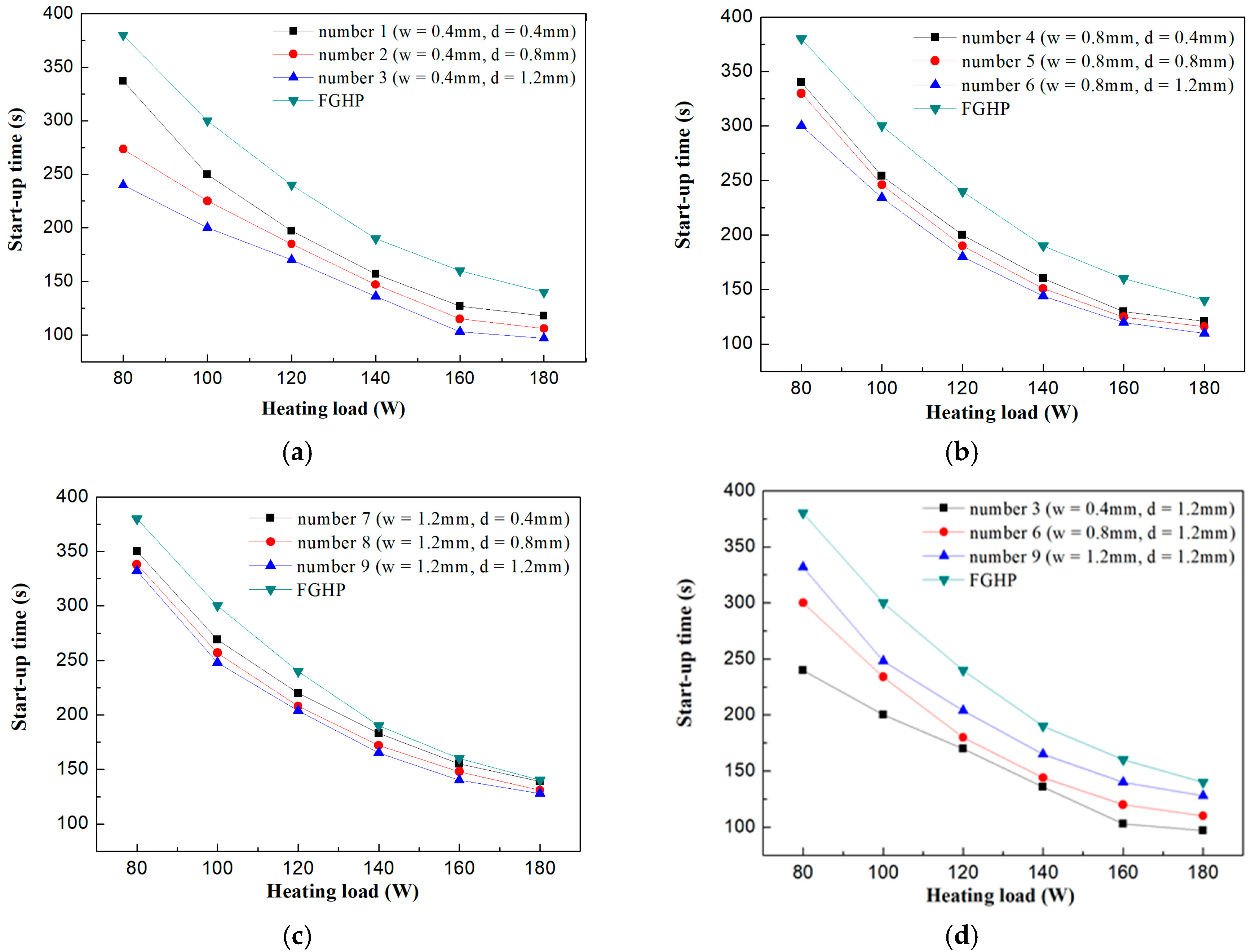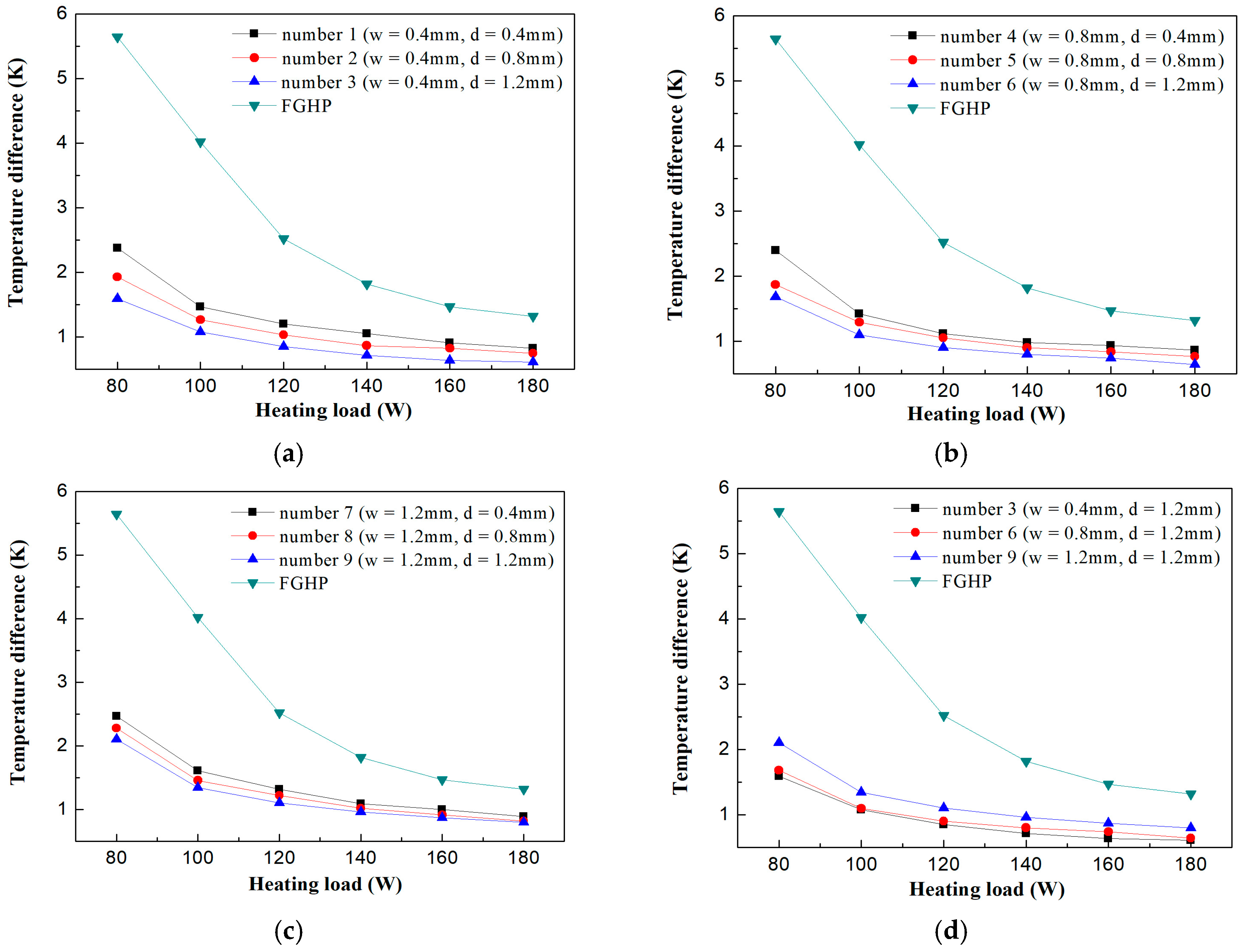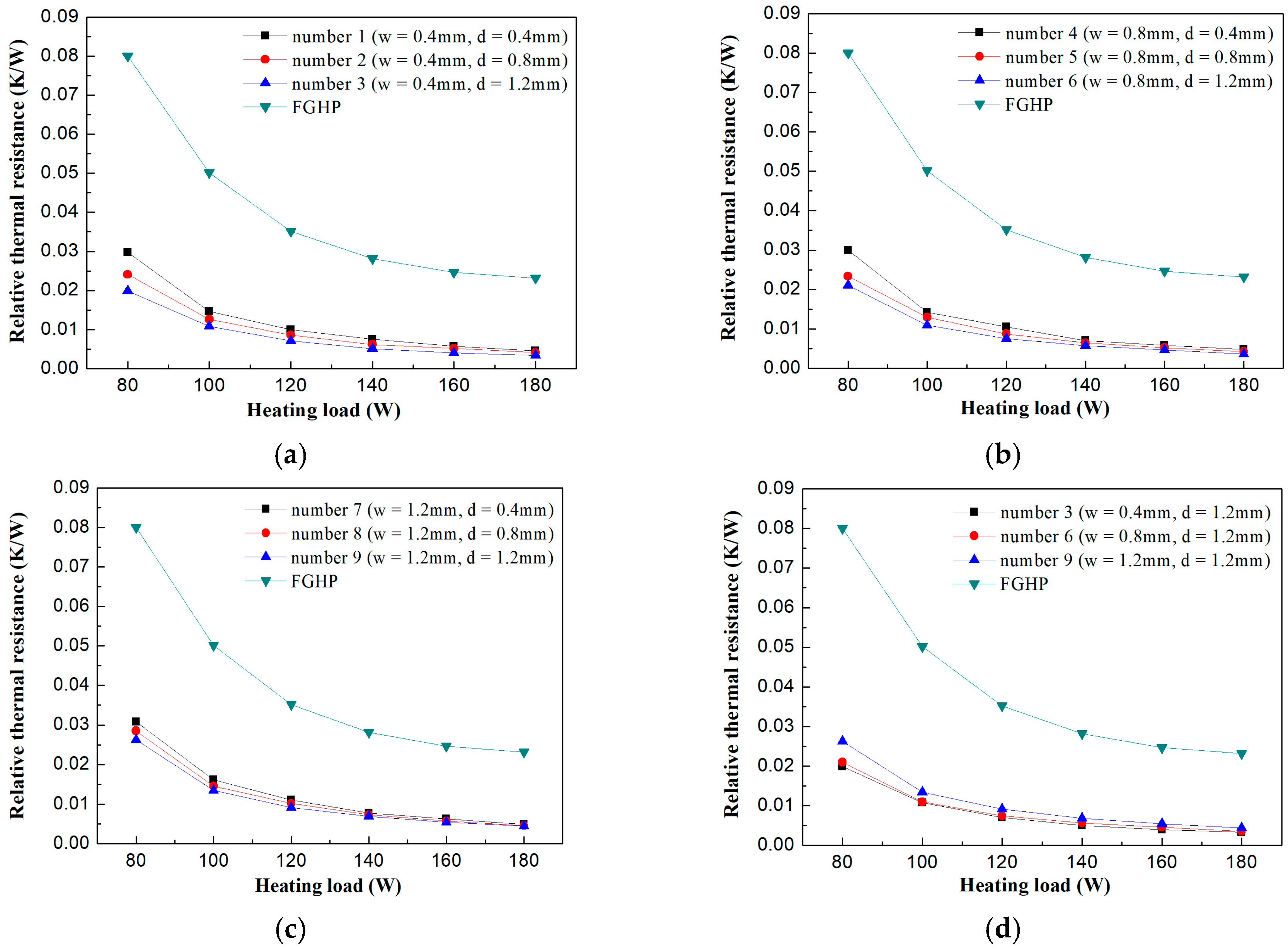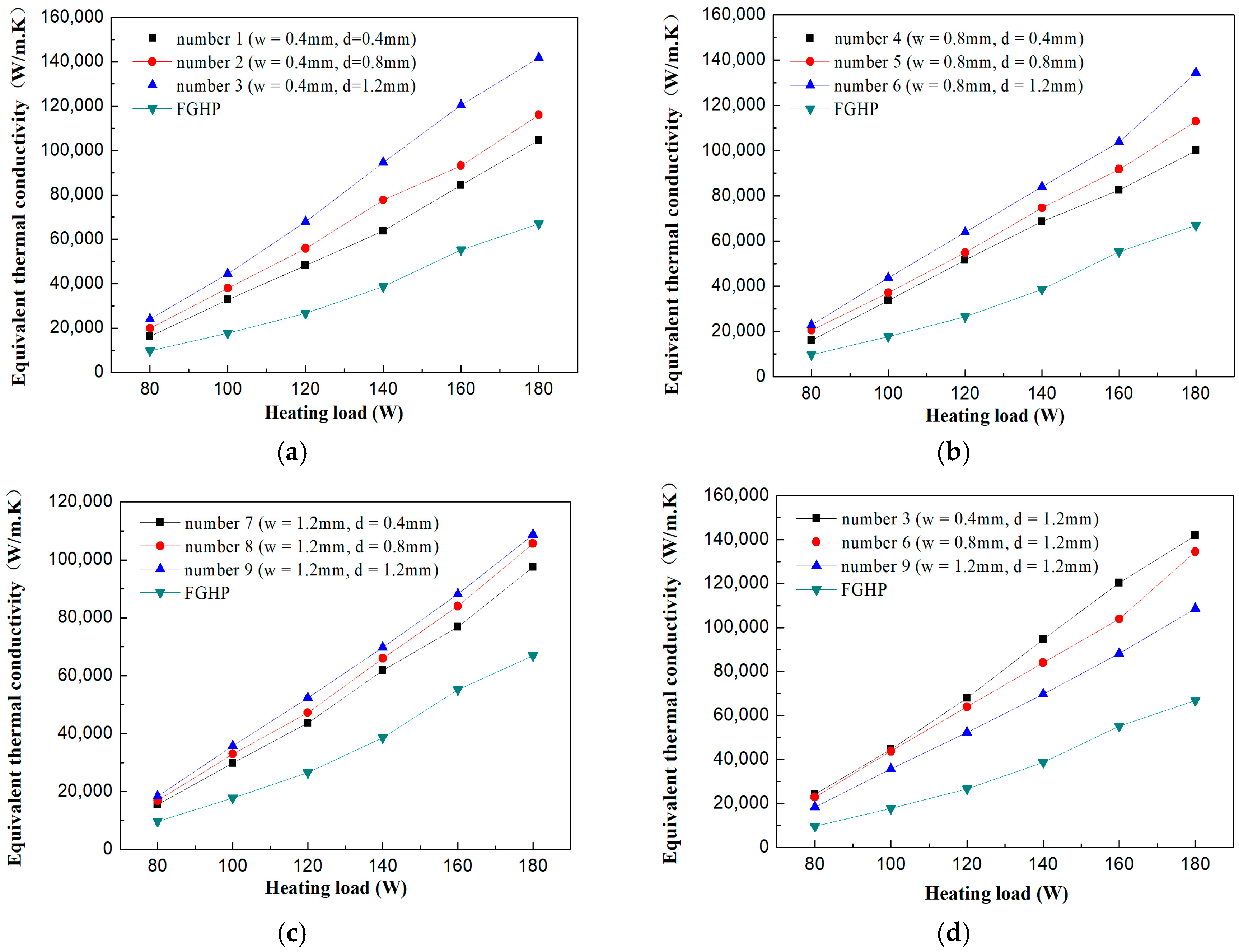Experimental Research on the Thermal Performance and Semi-Visualization of Rectangular Flat Micro-Grooved Gravity Heat Pipes
Abstract
:1. Introduction
2. Experimental
2.1. Fabrication of FMGHPs
2.2. Experimental System
2.3. Experimental Conditions
3. Thermal Performance Indicators
4. Results and Discussion
4.1. The Effects of FMGHP Micro-Grooves on Start-Up Time
4.2. The Effects of Micro-Grooves on FMGHPs on Temperature Difference
4.3. The Effects of Micro-Grooves on FMGHPs on Relative Thermal Resistance
4.4. The Effects of Micro-Grooves on FMGHPs on Equivalent Thermal Conductivity
4.5. The Semi-Visualization Comparison of FMGHP and FGHP
5. Conclusions
- (1)
- With the increasing heating load, the start-up time, temperature difference and relative thermal resistance of FMGHPs show a declining trend and the equivalent thermal conductivity is enhanced.
- (2)
- The deeper and narrower micro-grooves show better thermal performance and the optimal rectangular micro-groove dimension among the selected options is determined as 1.2 mm (depth) × 0.4 mm (width) within the experimental range.
- (3)
- The start-up time, temperature difference, relative thermal resistance and equivalent thermal conductivity of FMGHPs are all better than that of the FGHP. The four indicators of FMGHP 3, which has the best thermal performance among the nine FMGHPs, are enhanced by 29%, 66%, 80% and 155%, respectively.
- (4)
- At the same heating load, the liquid–vapor two-phase behaviors in the FMGHP are more intensive. Larger and more bubbles can be observed in the cavity of the FMGHP compared with the observations of the FGHP.
Author Contributions
Funding
Conflicts of Interest
References
- Yau, Y.H.; Ahmadzadehtalatapeh, M. A review on the application of horizontal heat pipe heat exchangers in air conditioning systems in the tropics. Appl. Therm. Eng. 2010, 30, 77–84. [Google Scholar] [CrossRef]
- Alijani, H.; Çetin, B.; Akkus, Y.; Dursunkaya, Z. Effect of design and operating parameters on the thermal performance of aluminum flat grooved heat pipes. Appl. Therm. Eng. 2018, 132, 174–187. [Google Scholar] [CrossRef]
- Lips, S.; Lefèvre, F.; Bonjour, J. Nucleate boiling in a flat grooved heat pipe. Int. J. Therm. Sci. 2009, 48, 1273–1278. [Google Scholar] [CrossRef]
- Li, Y.; He, H.F.; Zeng, Z.X. Evaporation and condensation heat transfer in a heat pipe with a sintered-grooved composite wick. Appl. Therm. Eng. 2013, 50, 342–351. [Google Scholar] [CrossRef]
- Yu, M.; Diallo, T.M.O.; Zhao, X.D.; Zhou, J.Z.; Du, Z.Y.; Ji, J.; Cheng, Y.D. Analytical study of impact of the wick’s fractal parameters on the heat transfer capacity of a novel micro-channel loop heat pipe. Energy 2018, 158, 746–759. [Google Scholar] [CrossRef]
- Tuckerman, D.B.; Pease, R.F.W. High performance heat sinking for VLSI. IEEE Electron Device Lett. 1981, 2, 126–129. [Google Scholar] [CrossRef]
- Wong, S.C.; Chen, C.W. Visualization and evaporator resistance measurement for a groove-wicked flat-plate heat pipe. Int. J. Heat Mass Transf. 2012, 55, 2229–2234. [Google Scholar] [CrossRef]
- Liu, X.D.; Chen, Y.P. Transient thermal performance analysis of micro heat pipes. Appl. Therm. Eng. 2013, 58, 585–593. [Google Scholar] [CrossRef]
- Suman, B.; Hoda, N. Effect of variations in thermophysical properties and design parameters on the performance of a V-shaped micro grooved heat pipe. Int. J. Heat Mass Transf. 2005, 48, 2090–2101. [Google Scholar] [CrossRef]
- Wu, H.Y.; Cheng, P. Visualization and measurements of periodic boiling in silicon microchannels. Int. J. Heat Mass Transf. 2003, 46, 2603–2614. [Google Scholar] [CrossRef]
- Jiao, A.J.; Ma, H.B.; Critser, J.K. Evaporation heat transfer characteristics of a grooved heat pipe with micro-trapezoidal grooves. Int. J. Heat Mass Transf. 2007, 50, 2905–2911. [Google Scholar] [CrossRef]
- Nagayama, G.; Gyotoku, S.; Tsuruta, T. Thermal performance of flat micro heat pipe with converging microchannels. Int. J. Heat Mass Transf. 2018, 122, 375–382. [Google Scholar] [CrossRef]
- Hopkins, R.; Faghri, A.; Khrustalev, D. Flat miniature heat pipes with micro capillary grooves. J. Heat Transf. 1999, 121, 102–109. [Google Scholar] [CrossRef]
- Do, K.H.; Kim, S.J.; Garimella, S.V. A mathematical model for analyzing the thermal characteristics of a flat micro heat pipe with a grooved wick. Int. J. Heat Mass Transf. 2008, 51, 4637–4650. [Google Scholar] [CrossRef] [Green Version]
- Saad, I.; Maalej, S.; Zaghdoudi, M.C. Combined effects of heat input power and filling fluid charge on the thermal performance of an electrohydrodynamic axially grooved flat miniature heat pipe. Appl. Therm. Eng. 2018, 134, 469–483. [Google Scholar] [CrossRef]
- Saad, I.; Maalej, S.; Zaghdoudi, M.C. Modeling of the EHD effects on hydrodynamics and heat transfer within a flat miniature heat pipe including axial capillary grooves. J. Electrostat. 2017, 85, 61–78. [Google Scholar] [CrossRef]
- Gillot, C.; Avenas, Y.; Cezac, N.; Poupon, G.; Schaeffer, C.; Fournier, E. Silicon heat pipes used as thermal spreaders. IEEE Trans. Compon. Packag. Technol. 2003, 26, 332–339. [Google Scholar] [CrossRef]
- Gou, X.; Li, Y.M.; Zhang, Q.Y.; Shah, I.A.; Zhao, D.; Liu, S.A.; Wang, Y.T.; Wang, E.Y.; Wu, J.X. A novel semi-visualizable experimental study of a plate gravity heat pipe at unsteady state. Energies 2017, 10, 1994. [Google Scholar]
- Kwon, G.H.; Kim, S.J. Experimental investigation on the thermal performance of a micro pulsating heat pipe with a dual-diameter channel. Int. J. Heat Mass Transf. 2015, 89, 817–828. [Google Scholar] [CrossRef]
- Yu, F.W.; Yu, C.; Cao, J.G.; Chen, Y.P. Experimental analysis of the evaporation regimes of an axially grooved heat pipe at small tilt angles. Int. J. Heat Mass Transf. 2018, 126, 334–341. [Google Scholar] [CrossRef]
- Ruckenstein, E.; Berim, G.O. Kinetics of heterogeneous nucleation on a rough surface: Nucleation of a liquid phase in nanocavities. J. Colloid Interface Sci. 2010, 351, 277–282. [Google Scholar] [CrossRef] [PubMed]
- Ji, X.B.; Xu, J.L.; Li, H.C. Huang, G.H. Switchable heat transfer mechanisms of nucleation and convection by wettability match of evaporator and condenser for heat pipes: Nanostructured surface effect. Nano Energy 2017, 38, 313–325. [Google Scholar] [CrossRef]
- Ruckenstein, E.; Djikaev, Y.S. Recent developments in the kinetic theory of nucleation. Adv. Colloid Interface Sci. 2005, 118, 51–72. [Google Scholar] [CrossRef] [PubMed]
- Baidakov, V.G.; Pankov, A.S. Nucleation in ethane–nitrogen solutions. I. Homogeneous nucleation. Int. J. Heat Mass Transf. 2015, 86, 930–935. [Google Scholar] [CrossRef]







| FMGHP Number | Depth (d) | Width (w) | Micro-Groove Length | Micro-groove Number |
|---|---|---|---|---|
| (mm) | (mm) | (mm) | ||
| 1 | 0.4 | 0.4 | 200 | 40 |
| 2 | 0.8 | |||
| 3 | 1.2 | |||
| 4 | 0.4 | 0.8 | ||
| 5 | 0.8 | |||
| 6 | 1.2 | |||
| 7 | 0.4 | 1.2 | ||
| 8 | 0.8 | |||
| 9 | 1.2 |
© 2018 by the authors. Licensee MDPI, Basel, Switzerland. This article is an open access article distributed under the terms and conditions of the Creative Commons Attribution (CC BY) license (http://creativecommons.org/licenses/by/4.0/).
Share and Cite
Gou, X.; Zhang, Q.; Li, Y.; Liu, Y.; Liu, S.; Iram, S. Experimental Research on the Thermal Performance and Semi-Visualization of Rectangular Flat Micro-Grooved Gravity Heat Pipes. Energies 2018, 11, 2480. https://doi.org/10.3390/en11092480
Gou X, Zhang Q, Li Y, Liu Y, Liu S, Iram S. Experimental Research on the Thermal Performance and Semi-Visualization of Rectangular Flat Micro-Grooved Gravity Heat Pipes. Energies. 2018; 11(9):2480. https://doi.org/10.3390/en11092480
Chicago/Turabian StyleGou, Xiang, Qiyan Zhang, Yamei Li, Yingfan Liu, Shian Liu, and Saima Iram. 2018. "Experimental Research on the Thermal Performance and Semi-Visualization of Rectangular Flat Micro-Grooved Gravity Heat Pipes" Energies 11, no. 9: 2480. https://doi.org/10.3390/en11092480




